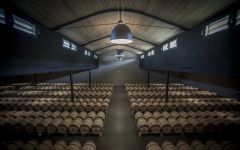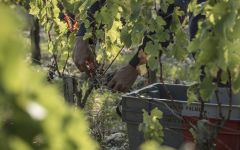Chateau Palmer Alter Ego de Palmer 2017
-
James
Suckling - Decanter
-
Wine
Spectator -
Wine
Enthusiast -
Jeb
Dunnuck -
Robert
Parker



Product Details
Your Rating
Somm Note
Winemaker Notes
Blend: 53% Merlot, 41% Cabernet Sauvignon, 6% Petit Verdot
Professional Ratings
-
James Suckling
This is a delicious and savory wine with beautiful, ripe and creamy tannins, as well as chocolate and plum character. Full body. The flavors turn to wet earth and mushrooms with some leather. A blend of 53% merlot, 41% cabernet sauvignon and 6% petit verdot. Lovely finish. Try after 2021.
-
Decanter
I love the bright perky fruit that we have here.They had to be careful with extraction to retain this delicacy but have been successful with it. Not enormously concentrated, at least compared to the first wine, but it has lovely classicism, with fresh fruit and some gourmet swirls of cinnamon and chocolate, 3.75pH, 25% new oak. Had some bigger sized oak casks also, testing for the first time on just 60hl. A yield of 38hl/ha because the Alter Ego plots frosted more than Palmer (final count 55% Palmer, 45% Alter Ego).
-
Wine Spectator
Lively, featuring lots of lavender and savory hints mixed with black cherry and plum flavors. Shows a light bramble note. Open-knit, with juicy energy on the finish.
Barrel Sample: 89-92 -
Wine Enthusiast
Attractive black-currant aromas of this wine are followed on the palate by fresh fruits, lit by acidity and bright black-currant and berry flavors. The tannins are soft and open, meaning this wine will develop relatively quickly. Drink from 2022.
-
Jeb Dunnuck
The 2017 Alter Ego De Palmer is a terrific wine and checks in as 53% Merlot, 41% Cabernet Sauvignon, and 6% Petit Verdot. Its deep purple color is followed by a powerful second wine that has lots of blackberry and assorted dark fruit as well as notes of leafy herbs, earth, and spice. it's nicely concentrated, medium to full-bodied, and has considerable class.
-
Robert Parker's Wine Advocate
Composed of 53% Merlot, 41% Cabernet Sauvignon and 6% Petit Verdot, the 2017 Alter Ego de Palmer is deep garnet-purple in color and springs from the glass with vivacious black raspberries, black cherries and crushed blackcurrants notes plus hints of Sichuan pepper, menthol, pencil lead and cardamom. Medium-bodied, the palate is charged with energy, featuring expressive, bright black fruits and firm, fine-grained tannins, finishing long and lively.
Other Vintages
2022-
James
Suckling -
Jeb
Dunnuck - Decanter
-
Robert
Parker
-
James
Suckling - Vinous
- Decanter
-
Jeb
Dunnuck -
Robert
Parker
-
James
Suckling -
Wine
Enthusiast - Decanter
-
Jeb
Dunnuck -
Robert
Parker
-
James
Suckling - Decanter
- Vinous
-
Jeb
Dunnuck -
Robert
Parker -
Wine
Spectator
-
James
Suckling -
Wine
Enthusiast -
Jeb
Dunnuck - Decanter
-
Robert
Parker -
Wine
Spectator
-
James
Suckling -
Wine
Enthusiast -
Jeb
Dunnuck -
Robert
Parker - Decanter
-
Wine
Spectator -
Wine
Enthusiast -
James
Suckling -
Robert
Parker - Decanter
-
Jeb
Dunnuck
-
James
Suckling -
Robert
Parker -
Wine
Enthusiast -
Wine
Spectator
-
Wine
Enthusiast -
Wilfred
Wong -
Wine
Spectator -
James
Suckling -
Robert
Parker
-
Wine
Enthusiast -
Wilfred
Wong -
James
Suckling -
Wine
Spectator -
Robert
Parker
-
Wine
Enthusiast -
Wine
Spectator
-
Wine
Spectator -
Wine
Enthusiast -
Robert
Parker
-
Wine
Spectator





Charles Palmer devoted a great deal of time, energy, and money to developing his property. The Major General lived mainly in England, and so the estate was managed by his authorized representative, Mr Grey, who helped to increase the wine's reputation among wealthy connoisseurs.
In June 1853, the brothers Isaac and Emile Péreire, famous bankers and rivals of the Rothschilds, bought Palmer and began investing in the estate immediately. However, there was not enough time to bring Chateau Palmer up to first growth status in time for the famous 1855 classification. It was thus ranked a Third Growth, although it is widely recognized as among the greatest wines of Bordeaux.
Several families of Bordeaux, English, and Dutch extraction all involved in the wine trade, united to buy Palmer in 1938 and have worked hard to give the estate its present reputation. These families have always given priority to quality, despite the financial risk this entailed. They have unfailingly applied the principles that have made the great wines of Bordeaux so successful: authenticity, quality, and permanence.
